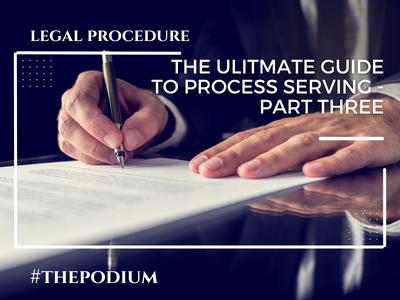
Final Post of a Three-Part Series
By Frank Long
Process Server: A Law Firm’s Strategic Partner
At the highest level of process servers are those who have the right stuff to become a strategic partner. A vendor that is qualified to fill this role may be affiliated with a larger litigation support service provider and, thus, invisible to the law firm itself. The litigation support service provider brings value to the law firm, however, with deep industry experience, a technology platform that delivers efficiency, and a provable history of high performance.
Technology for process serving
As a strategic partner, the litigation support service provider uses its technology platform to innovate a better way for the law firm to operate. One way it can do that is to make data about process service orders in the provider’s own system shareable with the law firm’s systems. This can be especially useful by making data instantly available about billing, court fees, vendor fees, and payments for process serving orders.
Interested in Learning Other Process Serving Technology Use Cases?
Read Technology Your Process Server Should Be Using
Data is better than a crystal ball
If you’re unclear about how sharing this data positively impacts the bottom line, think of it this way: For each case, every transaction receipt and every document can be stored in a law firm’s own system. This means fees and payments can be easily accounted for and reimbursed when the case ends, dramatically collapsing the time needed to reconcile expenses.
A portal also allows the vendor to manage and efficiently track the performance of its affiliate network in executing the serve. This, in turn, builds an extremely high level of accountability felt all along with the service of process supply chain.
The portal also creates two other important advantages to improve service of process efficiency: it eliminates paper controls and allows the server to eSign the proof of service.
Measure the results
Sharable data can also be used to create strategic reports. These reports provide detailed views of service of process orders and the vendor’s execution thereof, as well as other order types placed through the portal. At a glance, users can see which types of orders contribute positively to the firm’s bottom line and which types compromise it.
Most law firms lack the infrastructure and staff to collect business intelligence at this level easily. That’s why it’s important to have a vendor whose technology makes it simple to gather and share it. If your litigation support service provider isn’t able or willing to deliver this sort of value to help you grow, it’s probably time to find one that will.
4 ways you should be using sharable data in your firm’s business strategy:
- Service level distribution
- Orders by type
- Service of process orders by pricing zone
- Service of process performance
Read Technology Your Process Server Should Be Using and learn how these reports can save money for your law firm!
Expert advice is a click away
By reading this article, you’ve taken an important first step toward building your process serving expertise. The thing to remember about process serving—as the term implies—is that it is a process. It is a task filled with nuance that won’t be mastered overnight. So don’t be afraid to seek advice and expertise.
Addendum:
Most commonly served documents
A process server’s toolkit primarily consists of documents: paper or electronic. Each document performs a distinct function and some will significantly alter the course of business or relationships.
It’s critical to understand the legal action each document triggers, so we’ve defined them here in alphabetical order:
Complaint: The initial pleading in which an action is commenced and sets forth a claim for relief. The filing of the complaint is a charge against a defendant or several defendants and sets forth a cause or causes of actions against them.
Notice of Motion: A notice in writing stating that a certain day designated a motion will be made to the court for the purpose or object stated. The notice is served on opposing counsel and all parties and gives all parties a time and date for the court hearing.
Notice to Quit: This notice is given to tenants to terminate the tenancy of the premises. The notice states that at the end of the specified date, the tenancy is terminated and directs that the tenant must move out.
Notice to Pay Rent or Quit: A notice to a tenant of a rental property, informing him or her that the rent or a portion of the rent is due. Service on the tenant in writing that the rent is due usually in three days after the date of service, and if the rent is not paid, the tenant is requested to “quit” (leave) the premises.
Opposition: A pleading filed to oppose or state a reason a Motion should not be granted, otherwise known as a 1011.
Order for Appearance (ORAP): This is a court order that compels a personal appearance of the judgment debtor. Disobedience of this order by not appearing could subject the judgment debtor to a citation of contempt and ultimately lead to an arrest.
Order to Show Cause: An order to appear as directed, and presents to the court such reasons or considerations as one has to offer why a particular order should not be confirmed, take effect or to be executed.
Plaintiff’s Claim and Order to go to Small Claims Court: A claim of plaintiff is a small claims document filed by the plaintiff against the defendant of defendants. The claim must be for a monetary amount only. The claim is a 5-page document stating how the defendant or defendants damaged the plaintiff and in what amount.
Temporary Restraining Order: This is an order compelling compliance and failure to obey it could result in bringing the person restrained into contempt of court and possible arrest. A TRO is a case matter that might restrain the respondent from calling, harassing, or bothering the petitioner. The order is to restrain the person served from doing any act specified in the order until the hearing takes place.
Summons: A writ of process [issued by the clerk of the court] the person named that an action has been commenced against him in the court from where the process issues and that he/she is required to appear.
Subpoena: A command to appear at a certain time and place to give testimony as a witness.
About the Author:
Frank Long, MS, is a professional writer, editor, and content creator. He is a graduate of the Brian Lamb School of Communication at Purdue University and content marketing manager for Rapid Legal. He may be contacted at flong@rapidlegal.com.
If you would like to go back and review the previous posts of this series, click on the links below:
Part One – The Ultimate Guide to Process Serving
Part Two – The Process Server’s Bread and Butter
Categorized in: Legal Procedure
| << previous | next >> |








